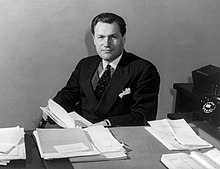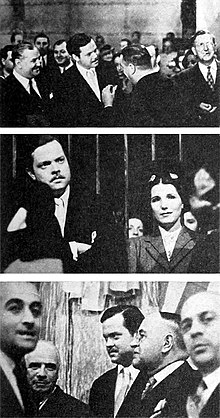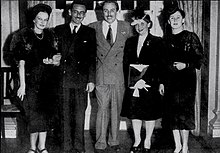
The Office of the Coordinator of Inter-American Affairs, later known as the Office for Inter-American Affairs, was a United States agency promoting inter-American cooperation (Pan-Americanism) during the 1940s, especially in commercial and economic areas. It was started in August 1940 as OCCCRBAR (Office for Coordination of Commercial and Cultural Relations between the American Republics) with Nelson Rockefeller as its head, appointed by President Franklin Delano Roosevelt.[1][2]
The Office of Coordinator of Inter-American Affairs in the Executive Office of the President was formally established and enacted by US Executive Order 8840 on July 30, 1941, by President Roosevelt[3][4] who named Nelson Rockefeller as the Coordinator of Inter-American Affairs (CIAA).
The agency's function was to counter Italian and German propaganda in the region. The FBI trained the secret police of friendly nations. German sales to military forces was displaced by American aid. Pro-German newspapers and radio stations were blacklisted. Government censorship was encouraged, while Latin America was blanketed with pro-American propaganda. The OCIAA grew to be a large Federal agency with a budget of $38 million and 1,500 employees by 1943. 1942.[5][6]
It was later renamed the Office of Inter-American Affairs (OIAA) with slightly changed powers by Executive order 9532 on March 23, 1945.[7]
Mission
[edit]

| External audio | |
|---|---|
The Office of the Coordinator of Inter-American Affairs was established in August 1940 by order of the U.S. Council of National Defense, and operated with funds from both the government and the private sector.[8]: 10–11 By executive order July 30, 1941, President Franklin D. Roosevelt established the OCIAA within the Office for Emergency Management of the Executive Office of the President, "to provide for the development of commercial and cultural relations between the American Republics and thereby increasing the solidarity of this hemisphere and furthering the spirit of cooperation between the Americas in the interest of hemisphere defense."[9]
The mission of the OCIAA was cultural diplomacy, promoting hemispheric solidarity and countering the growing influence of the Axis powers in Latin America. The OCIAA's Motion Picture Division played an important role in documenting history and shaping opinion toward the Allied nations, particularly after the U.S. entered World War II in December 1941. To support the war effort — and for their own audience development throughout Latin America — Hollywood studios partnered with the U.S. government on a nonprofit basis, making films and incorporating Latin American stars and content into their commercial releases.[8]: 10–11
During the 1940s the CBS radio broadcasting network also contributed to the OCIAA's cultural initiatives by establishing the CBS Pan American Orchestra to showcase prominent musical artists from both North and South America on its Viva América program. Broadcasts to Latin America were coordinated by the OCIAA with CBS' "La Cadena de Las Américas" (Network of the Americas) shortwave radio and radiotelephone systems as envisioned by William S. Paley.[10] Included among the international contributors were: Alfredo Antonini (Italian-American conductor), Terig Tucci (Argentine composer), John Serry Sr. (Italian-American accordionist),[11] Elsa Miranda (Puerto Rican vocalist), Eva Garza (Mexican-American vocalist), Nestor Mesa Chaires (Mexican tenor), Juan Arvizu (Mexican tenor), Manolita Arriola (Mexican vocalist) [12] and Edmund A. Chester (American journalist).[13][14][15][16][17][18][19][20][21][22] The OCIAA also supported cultural programming on the CBS radio network which included performances by such Hollywood luminaries as Edward G. Robinson and Rita Hayworth.[23]
Artists working in a variety of disciplines were appointed goodwill ambassadors to Latin America by the OCIAA, which also sponsored a variety of cultural tours. A select listing includes Misha Reznikoff and photojournalist Genevieve Naylor (October 1940–May 1943); Bing Crosby (August–October 1941); Walt Disney (August–October 1941); Aaron Copland (August–December 1941); George Balanchine and the American Ballet (1941); Orson Welles (1942); Rita Hayworth (1942); Grace Moore (1943); and John Ford and Gregg Toland (1943).[8]: 245
Activities
[edit]

In its early days, a particular concern of the OCIAA was the elimination of German influence in South America, and that of other Axis powers. Trade routes to Europe were disrupted following the fall of France in June 1940, presenting opportunities to both Germany and the U.S. At the same time, many agents or affiliates of U.S. firms operating in Latin America were sympathetic to European Axis powers. The office encouraged a voluntary program of non-cooperation with companies and individuals perceived to be anti-American. To this end it cooperated secretly with British Security Co-ordination in New York. Though isolated in Europe, Britain maintained an extensive intelligence network in Latin America, and was happy to undermine Germany's trade efforts overseas by identifying sympathisers and agents. Through these efforts, U.S. exporters were encouraged to drop over a thousand accounts in South America during the first half of 1941.[24]
The office was also concerned with public opinion in Latin America. It translated and disseminated relevant speeches by President Roosevelt, and distributed pro-U.S materials to features syndicates in the region. It carried out audience research surveys and encouraged radio broadcasters targeting these regions to improve the quality of their programming. In order to discourage opposing views it created a 'Proclaimed List', a black-list of newspapers and radio stations owned or influenced by Axis powers. Latin American firms wishing to do business with America were discouraged from dealing with these stations. Tax incentives were also used: spending by American firms on unprofitable longwave transmission to Latin America could be deducted from income tax payments. Likewise, spending on approved advertising in Latin America became deductible from corporate income taxes.[5]
Walt Disney and a group of animators had been sent to South America in 1941 by the U.S. State Department as part of its Good Neighbor policy, and guaranteed financing for the resulting movie, Saludos Amigos (1942).[25] In 1944, William Benton, publisher of the Encyclopædia Britannica, had entered into unsuccessful negotiations with Disney to make six to twelve educational films annually. Disney was asked to make an educational film about the Amazon basin and it resulted in the 1944 short, The Amazon Awakens.[26][27][28][29][30]
Postwar
[edit]By an Executive order of August 31, 1945, the informational activities of the Office of Inter-American Affairs were transferred to the Department of State. It became known as the Office for Inter-American Affairs. By an Executive order of April 10, 1946, the Office was abolished and its remaining functions and responsibilities were transferred to the State Department.[31]
Personnel
[edit]- Nelson Rockefeller, Coordinator of the Office for Coordination of Commercial and Cultural Relations between the American Republics and Coordinator of Inter-American Affairs (1940–44):
- Wallace Harrison, Director of the Office for Inter-American Affairs (1945–46)
Soviet penetration
[edit]The Office of the Coordinator of Inter-American Affairs was penetrated by Soviet intelligence during World War II. The agency's code name in Soviet intelligence and in the Venona project is "Cabaret".[32]: 200 These American citizens were employees of the OCIAA and engaged in espionage on behalf of the Soviet Union:
- Marion Davis Berdecio[32]: 201, 346
- Jack Fahy[32]: 187
- Joseph Gregg[32]: 111, 114
- Helen Grace Scott Keenan[32]: 204
- Robert Talbott Miller[32]: 111, 114
- Willard Park[32]: 101
See also
[edit]References
[edit]- ^ Thomson, Charles Alexander Holmes, Overseas information service of the United States Government, The Brookings Institution, 1948. Cf. p. 4.
- ^ Dissonant Divas in Chicana Music: The Limits of La Onda Deborah R. Vargas. University of Minnesota Press, Minneapolis, 2012 p. 152-155 ISBN 978-0-8166-7316-2 OCIAA (Office of the Coordinator of Inter-American Affairs), FDR's Good Neighbor Policy, CBS, Viva America, La Cadena de las Americas on google.books.com.
- ^ "Executive Order 8840 Establishing the Office of Coordinator of Inter-American Affairs. | The American Presidency Project". www.presidency.ucsb.edu. Retrieved March 26, 2019.
- ^ "1941: Executive Order 8840", Federal Register, 1941.
- ^ a b Gerald K. Haines (1977). "Under the Eagle's Wing: The Franklin Roosevelt Administration Forges An American Hemisphere". Diplomatic History. 1 (4): 373–388. doi:10.1111/j.1467-7709.1977.tb00248.x. JSTOR 24909904.
- ^ Anthony, Edwin D. (1973). Records of the Office of Inter-American Affairs (PDF). Vol. Inventory of Record Group 229. Washington D.C.: National Archives and Record Services - General Services Administration. pp. 1–8. LCCN 73-600146.
- ^ "1945: Executive Order 9532", Federal Register, 1945.
- ^ a b c Benamou, Catherine L., It's All True: Orson Welles's Pan-American Odyssey. Berkeley: University of California Press, 2007 ISBN 978-0-520-24247-0.
- ^ Roosevelt, Franklin D., "Executive Order 8840 Establishing the Office of Coordinator of Inter-American Affairs", July 30, 1941. Online by Gerhard Peters and John T. Woolley, The American Presidency Project, University of California, Santa Barbara.
- ^ Dissonant Divas in Chicana Music: The Limits of La Onda Deborah R. Vargas. University of Minnesota Press, Minneapolis, 2012 pp. 152-153 ISBN 978-0-8166-7316-2 OCIAA and William S. Paley's Cadena De Las Americas on google.books.com.
- ^ Eastman School of Music - University of Rochester - Sibley Music Library: John J. Serry Sr. Collection: Autographed Photograph of John Serry accordionist on CBS' C de Las A program circa 1940s p. 3, Series 3, Collection Box 3, Item 1: The John J. Serry Sr. Collection archived at the University of Rochester Eastman School of Music
- ^ Photographs of Manolita Arriola on the "Viva America" program in 1946 on Getty Images
- ^ "Copyright 2019, J. David Goldin". Archived from the original on February 6, 2012. Retrieved June 12, 2017.
- ^ The New York Times, January 8, 1941, p. 8.
- ^ The New York Times, January 1, 1942, p. 27.
- ^ The New York Times, May 10, 1942, p. SM10.
- ^ The New York Times, February 28, 1943, p. X9.
- ^ The New York Times, January 18, 1942, p. 27.
- ^ Settel, Irving (1967) [1960]. A Pictorial History of Radio. New York: Grosset & Dunlap. p. 146. LCCN 67-23789. OCLC 1475068.
- ^ Media Sound & Culture in Latin America & The Caribbean. Editors: Bronfman, Alejandra & Wood, Andrew Grant. University of Pittsburgh Press, Pittsburgh, PA, USA, 2012, p. 49 ISBN 978-0-8229-6187-1 Books.Google.COm See p. 49.
- ^ The Strachwitz Frontera collection of Mexican and Mexican American Recordings- Eva Garza Biography on frontera.library.ucla.edu.
- ^ Dissonant Divas in Chicana Music: The Limits of La Onda Deborah R. Vargas. University of Minnesota Press, Minneapolis, 2012 pp. 155-157 ISBN 978-0-8166-7316-2 Eva Garza and Viva America on google.books.com.
- ^ Dissonant Divas in Chicana Music: The Limits of La Onda Deborah R. Vargas. University of Minnesota Press, Minneapolis, 2012 p. 153 ISBN 978-0-8166-7316-2 OCIAA, CBS radio and Edward G. Robinson and Rita Hayworth on google.books.com.
- ^ Kramer, Paul (January 1, 1981). "Nelson Rockefeller and British Security Coordination". Journal of Contemporary History. 16 (1): 73–88. doi:10.1177/002200948101600105. S2CID 159608715.
Immediately after the fall of France there was unanimity of feeling within the Roosevelt administration that something had to be done about Latin America...
- ^ Walt & El Grupo (documentary film, 2008).
- ^ Gabler, 2006, p. 444.
- ^ Cramer, Gisela; Prutsch, Ursula, "Nelson A. Rockefeller's Office of Inter-American Affairs (1940-1946) and Record Group 229", Hispanic American Historical Review 2006 86(4):785-806; doi:10.1215/00182168-2006-050. Cf. p. 795 and note 28.
- ^ Bender, Pennee. "Hollywood Meets South American and Stages a Show" Paper presented at the annual meeting of the American Studies Association. 2009-05-24 <http://www.allacademic.com/meta/p114070_index.html>.
- ^ Niblo, Stephen R., "Mexico in the 1940s: Modernity, Politics, and Corruption", Wilimington, Del. : Scholarly Resources, 1999. ISBN 0-8420-2794-7. Cf. "Nelson Rockefeller and the Office of Inter-American Affairs", p. 333.
- ^ Leonard, Thomas M.; Bratzel, John F., Latin America during World War II, Rowman & Littlefield Publishers, Inc., 2007. ISBN 978-0-7425-3741-5. Cf. p. 47.
- ^ "Records of the office of Inter-American Affairs [OIAA]". August 15, 2016. Retrieved May 29, 2022 – via National Archives.
- ^ a b c d e f g Haynes, John Earl; Klehr, Harvey (2000) [1999]. Venona: Decoding Soviet Espionage in America. New Haven; London: Yale University Press. ISBN 9780300084627.
Further reading
[edit]- Erb, Claude C. "Prelude to point four: the Institute of Inter-American Affairs." Diplomatic History 9.3 (1985): 249–269.
- Haines, Gerald K. "Under the Eagle's Wing: The Franklin Roosevelt Administration Forges an American Hemisphere." Diplomatic History 1.4 (1977): 373–388. online.
- Maxwell, Allen Brewster, Evoking Latin American collaboration in the Second World War: A study of the Office of the Coordinator of Inter-American Affairs (1940–1946), PhD dissertation, Tufts University, Medford, MA., 1971.
- Reich, Cary. The Life of Nelson A. Rockefeller: Worlds to Conquer, 1908-1958 (1996), pp. 260–373; the standard scholarly biography.
- Rowland, Donald W., History of the Office of the Coordinator of Inter-American Affairs, US Government Printing Office, 1947. (United States Office of Inter-American Affairs).
- Smith, Richard Norton. On his own terms: A life of Nelson Rockefeller (2014), pp. 143–88 a standard scholarly biography.
External links
[edit]- Records of the Office of Inter-American Affairs at the U.S. National Archives and Records Administration
- Close-Up: Nelson A. Rockefeller; As Coordinator of Inter-American Affairs, a celebrated young heir runs a much-discussed and increasingly important Washington bureau. Busch, Noel F., Life, April 27, 1942, pp. 80–90
- Rockefeller Family Archives, Record Group #04, Record Group Name: Nelson A. Rockefeller, Personal, Washington, D.C. Files - Coordinator of Inter-American Affairs, Dates: August 1940-December 1944
Films at the Internet Archive
- The Grain That Built a Hemisphere (1942, Walt Disney Productions)
- Defense Against Invasion (1943, Walt Disney Productions)
- The Winged Scourge (1943, Walt Disney Productions]
- Wooden Face of Tontonicapan (Guatemala Sketch Book)
- São Paulo, Brazil (1944)
- Health for the Americas series by Walt Disney Productions
- What Is Disease? (1944)
- Cleanliness Brings Health (1944)
- Infant Care and Feeding (1944)
- Insects as Carriers of Disease (1944)
- Planning for Good Eating (1945)
- Environmental Sanitation
- Julien Bryan Productions